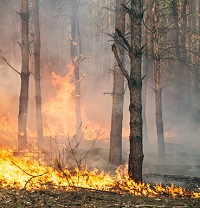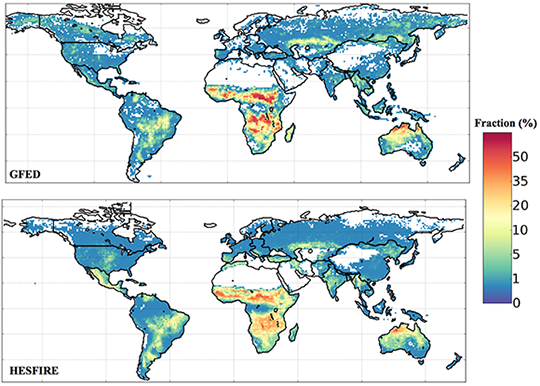Atmospher Sci & Global Chg
Research Highlights
March 2015
We're On Fire Now
Scientists developed global model on the role of human activity and weather on vegetation fires

Tracking Fire. Researchers led by PNNL scientists developed a new global vegetation fire model to anticipate fire activity based on natural phenomena and human influence.
Results: An international team of researchers led by Pacific Northwest National Laboratory working at the Joint Global Change Research Institute developed a new model on vegetation fires that will improve understanding of such fires around the world today. It can also predict their evolution with future changes in the environment and society. As reported in Biogeosciences, HESFIRE (Human-Earth System FIRE) integrates the role of atmospheric changes like humidity, terrestrial factors like the amount of vegetation available to burn, and human interactions with the environment.
"The model builds on previous research but adds new features not previously considered," said Dr. Yannick Le Page, a PNNL forestry scientist, who led the team. "It includes how fire spreads over consecutive days and realistically represents fire incidence across regions as well as extreme events."
Why It Matters: Forest and grassland fires can change the landscape, affecting biodiversity, farming, and even climate. These vegetation fires spew greenhouse gasses and particles into the atmosphere, adding their contribution to those of industrial pollutants and the burning of fossil fuels. Being able to predict where fire activity might change is key to anticipating how that activity might impact the environmental and society. But the cause of fires is a complex web of weather, nature, timing, and human factors that is very difficult to untangle.
The new model will allow scientists to explore potential fire trends under future conditions, identify hotspots particularly susceptible to changes in climate and human activities, and integrate results with other models tracking air quality and biodiversity.
Methods: Scientists at PNNL's Joint Global Climate Change Research Institute (JGCRI), NASA, the University of Lisbon, and the University of Maryland designed the HESFIRE model around three areas:
- Fire ignition—how fires start, including weather-related factors such as lightning strikes and human-related factors such as agriculture, ecosystem management, and other land use practices.
- Fire spread—how fires grow based on weather conditions such as relative humidity, temperature, and wind speed, and vegetation conditions such as soil moisture and the kinds of plants available (forest, shrub, or grass)
- Fire termination—what controls the way fires burn out, whether from natural causes such as weather conditions and fuel availability or human factors such as changes in the landscape and fire suppression efforts.
The research team then evaluated the model using satellite data from fires around the world to ensure HESFIRE correctly matched real-world results. Their evaluation highlighted the strengths of the model and also identified some areas for improvement.

Average annual burned fraction of land. Burned areas observed on natural landscapes is shown in the top panel. The bottom panel shows the burned fraction as modeled by HESFIRE.
What's Next? Scientists are working to improve the way HESFIRE represents fires in primarily pine (boreal) forests. They are also looking at a more comprehensive way to represent human influences, such as deforestation, agriculture, and firefighting practices, and how fires start.
Acknowledgments
Sponsors: The U.S. Department of Energy's (DOE's) Office of Science, Office of Biological and Environmental Research, Integrated Assessment of Global Climate Change program and the NASA Terrestrial Ecology and Interdisciplinary Studies programs funded this work.
Research Team: Yannick Le Page and Ben Bond-Lamberty, PNNL's JGCRI; Douglas Morton, NASA Goddard Space Flight Center; José M.C. Pereira, University of Lisbon; and George Hurtt, University of Maryland. The Joint Global Change Research Institute (JGCRI), located in College Park, is a partnership between PNNL and the University of Maryland.
Research Area: Climate & Earth Systems Science
Reference: Le Page Y, D Morton, B Bond-Lamberty, JMC Pereira, and G Hurtt. 2015. "HESFIRE: a Global Fire Model to Explore the Role of Anthropogenic and Weather Drivers." Biogeosciences 12: 887-903. DOI:10.5194/bg-12-887-2015
